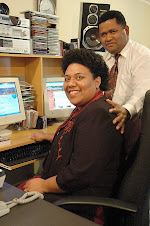 SHE spends most of her time, seven days a week selling produce at the market. Sushila Devi, 42, (pictured) is one of three Indian vendors at the Makoi Market in Nasinu.
SHE spends most of her time, seven days a week selling produce at the market. Sushila Devi, 42, (pictured) is one of three Indian vendors at the Makoi Market in Nasinu. She has been selling vegetables there for the past 13 years and said business was not as good as it used to be.
But Ms Devi has over the years made many good friends with other vendors.
"They are all friends," she said. "We have to look after each other." A few minutes later, she calls out to another vendor. "I've being selling her vegetables for her because she was feeling sick and went to see the doctor (at the health centre across the road)."
Ms Devi said her husband, who sells vegetables with her, had gone to the supermarket so she sat and talked to her friend, Puspha. Among their produce are cabbages, tomatoes, chillies, corn, pumpkin, okra, rourou, bean, cucumber and the list goes on.
They buy vegetables from farmers in Suva or Nausori. Ms Devi's petite size could have you mistake her for a woman 10 years her junior. You would find it hard to believe that she has two sons, Ranish, 23, and Shalvin, 17. Her eldest is a school teacher at a rural school in Ba, while Shalvin no longer attends school because of an injury.
Ms Devi and her husband travel from their home at Naduru Feeder Road in Kuku, Nausori. But Ms Devi is originally from Makoi and her family still lives there. She was educated at Bhawani Dayal primary and high schools. After completing school and at the age of 18, she married her husband.
Every morning Ms Devi wakes up early, prepares the family's breakfast and makes sure that everything is okay for her father-in-law, who is 85. "My father-in-law lives with us so I have to make sure that he is okay and that his meals are cooked because he's old," she said. After all the preparations and cleaning is complete, the couple leave home at about 8.30am on weekdays for Makoi.
"We are lucky that we have a van," she said. "But we are still paying it off. "We leave the market around 6.30pm. We can no longer stay late because it's not very safe. "When we leave in the evening all we do is cover the vegetables and a watchman looks after our stalls."
On Saturday and Sunday, the couple also sells at the market but only this time they leave home at 6.30am. Ms Devi says while the price of just about everything has increased, she still finds the time to sit with her friends, tell stories and make it a point to enjoy the day.
Adapted from Fijitimes Online






